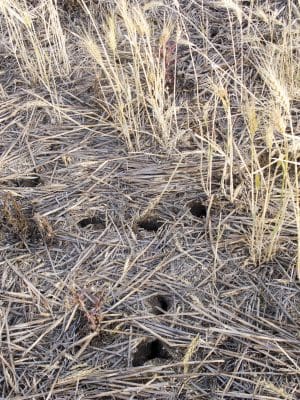GRAIN growers are advised to remain vigilant by monitoring mouse numbers locally in the lead up to sowing.
 The latest meeting of the National Mouse Group (NMG) heard reports of moderate to high mouse activity from the Darling Downs and Roma in Queensland, parts of the Eyre Peninsula in South Australia, and parts of Western Australia.
The latest meeting of the National Mouse Group (NMG) heard reports of moderate to high mouse activity from the Darling Downs and Roma in Queensland, parts of the Eyre Peninsula in South Australia, and parts of Western Australia.
The NMG, a Grains Research and Development Corporation (GRDC) investment, is a grower-led working group that provides growers with the latest advice and information to support effective, timely, and safe best-practice mouse management.
Chair and north-west Victorian grower Ian Hastings highlighted the need for considered yet quick action.
“Strategic baiting six weeks out from sowing in areas of high mouse activity can reduce local populations and stop population growth but be prepared to bait again at sowing if mice are still a problem,” Mr Hastings said.
Darling Downs, Qld, grower and NMG member Brendan Taylor shared his concerns about rising mouse numbers.
“I’m seeing mice across the roads in my local area, which is concerning,” Mr Taylor said.
GRDC pest manager Leigh Nelson said GRDC was dedicated to advancing mouse-management strategies to reduce the impact of rising mouse populations in key grain-growing regions.
“We have invested in research to better understand mouse ecology, behaviour, and population dynamics, while also promoting the widespread adoption of effective management practices through strong communication and extension efforts,” Dr Nelson said.
Look for burrows, logging advised
CSIRO researcher Steve Henry said the best way to confirm mouse activity was by walking paddocks to look for mouse burrows.
“The goal of baiting is to ensure mice consume a lethal dose,” Mr Henry said.
“Any background food can decrease baiting effectiveness, as it lowers the chances of mice encountering a lethal dose.

Growers are asked to look for mouse burrows in paddocks and report findings. Photo: GRDC
“Therefore, it’s important to check the amount of background food in paddocks and, where possible, reduce it before baiting.
“By the time you’re seeing mouse activity, it’s almost too late.
“Mouse numbers increase really quickly and farmers need to be vigilant to ensure numbers don’t get out of control.”
Growers are asked to log local mouse activity through the MouseAlert website, via X using @MouseAlert or through the FeralScan Pest Mapping app; this data is key for researchers to refine and verify forecast models.
The NMG brings together farmers from all mainland states, along with agronomists, peak bodies, industry groups, GRDC representatives, state government departments, and CSIRO researchers.
The group receives updates on mouse activity and research progress, including studies on mouse diseases, population modelling, ecology, surveillance and detection, and bait-spreading technology.
Source: GRDC